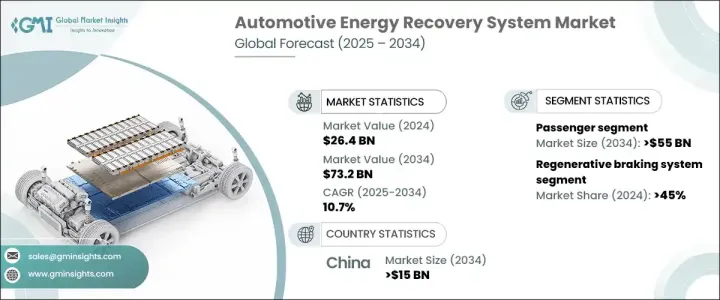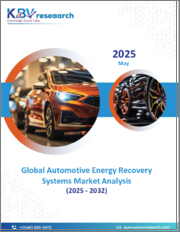
|
시장보고서
상품코드
1684847
자동차용 에너지 회생 시스템 시장 기회, 성장 촉진요인, 산업 동향 분석, 예측(2025-2034년)Automotive Energy Recovery System Market Opportunity, Growth Drivers, Industry Trend Analysis, and Forecast 2025 - 2034 |
||||||
세계의 자동차용 에너지 회생 시스템 시장 규모는 2024년에 264억 달러로 평가되었고 2025년부터 2034년에 걸쳐 10.7%의 연평균 복합 성장률(CAGR)을 나타낼 것으로 전망되고 있습니다.
이러한 놀라운 성장은 소비자와 자동차 제조업체들이 연료 효율성과 환경 친화적인 운송 솔루션을 선호하기 때문에 전기자동차와 하이브리드 차량에 대한 수요가 증가하고 있다는 요인이 되었습니다. 에너지 회수 시스템은 탄소 배출을 최소화하면서 차량 성능을 향상시키는 중요한 요소로, 세계의 지속가능성 추진에 부합하고 있습니다. 특히, 세계 각국의 정부가 보다 엄격한 환경규제를 실시하고 있기 때문에 자동차 제조업체는 연료 효율을 개선하고 유해한 배출을 삭감하는 첨단 에너지 회생 기술의 채용을 강요하고 있습니다. 이러한 시스템은 대기오염과 기후 변화에 대한 우려 증가에 대응하기 위해 매우 중요한 진화하는 배기가스 규제를 충족시키는데 필수적입니다.

자동차 산업이 진화를 계속하고 있는 가운데, 에너지 회생 시스템의 채용은 자동차의 효율 향상에 매우 중요한 역할을 하고 있습니다. 자동차 제조업체는 회생 브레이크, 터보 과급, 배기 가스 재순환 등의 시스템을 통합하여 차량 전체의 성능을 향상시키면서 친환경 차량에 대한 수요 증가에 대응하고 있습니다. 자동차용 에너지 회생 시스템 시장은 승용차와 상용차 모두에서 성장하고 있지만, 승용차는 생산량이 많고 널리 보급되어 시장을 독점하고 있습니다. 전기자동차와 하이브리드차에 대한 세계 수요 증가가 예상되고 있는 가운데, 환경과제에 대처하기 위한 신기술이 등장함에 따라 시장은 계속 확대될 것으로 보입니다.
| 시장 범위 | |
|---|---|
| 시작 연도 | 2024년 |
| 예측 연도 | 2025-2034년 |
| 시작 금액 | 264억 달러 |
| 예측 금액 | 732억 달러 |
| CAGR | 10.7% |
승용차 부문은 2024년에는 80% 시장 점유율을 차지했고, 2034년에는 550억 달러에 이를 것으로 예측됩니다. 승용차의 우위성이 계속되고 있는 것은 생산율이 높은 것, 연비가 잘 지속 가능한 교통 수단을 요구하는 소비자의 기호에 기인하고 있습니다. 자동차 제조업체가 엄격한 배기가스 규제를 준수하기 위해 노력하는 동안 특히 회생 제동 시스템은 이러한 자동차에서 일반적인 기능이되고 있습니다. 이 시스템은 제동시 운동 에너지를 회수하고 나중에 사용하기 위해 저장하며 연비 향상에 직접 기여합니다. 이 기능은 환경 문제와 규제 압력이 증가함에 따라 전기자동차와 하이브리드 자동차의 도입이 진행됨에 따라 특히 중요 해지고 있습니다.
제품 유형별로는 회생 제동 시스템이 2024년 시장 점유율 45%를 차지했습니다. 제동시에 에너지를 회수하는 기능에 의해 전기자동차나 하이브리드차의 에너지 회생 시스템의 중요한 일부가 되고 있습니다. 이러한 자동차가 계속 보급됨에 따라 회생 제동 시스템 수요가 증가하고 시장 채용이 더욱 가속될 것으로 예상됩니다.
지역별로 중국은 시장을 선도해 2024년 세계 점유율의 60%를 차지했습니다. 일본은 전기자동차의 급속한 보급과 녹색기술에 대한 노력을 통해 에너지 회생 시스템의 리더로서의 지위를 확립하고 있습니다. 지속가능성 촉진을 목적으로 하는 정부의 우대조치, 정책, 보조금이 이러한 시스템 수요를 뒷받침하고 있습니다. 중국 자동차 제조업체는 엄격한 환경 규제를 충족하기 위해 그린 테크놀러지을 선호하고 있으며 중국 시장은 2034년까지 150억 달러에 이를 것으로 예상됩니다.
목차
제1장 조사 방법과 조사 범위
- 조사 디자인
- 조사 접근
- 데이터 수집 방법
- 기본 추정과 계산
- 기준연도의 산출
- 시장추계의 주요 동향
- 예측 모델
- 1차 조사와 검증
- 1차 정보
- 데이터 마이닝 소스
- 시장 정의
제2장 주요 요약
제3장 업계 인사이트
- 생태계 분석
- 공급자의 상황
- 부품 공급자
- 제조업체
- 기술 제공업체
- 유통업체
- 최종 사용자
- 이익률 분석
- 가격 분석
- 특허 상황
- 비용 내역
- 기술과 혁신의 전망
- 주요 뉴스 및 이니셔티브
- 규제 상황
- 영향요인
- 성장 촉진요인
- 전기자동차와 하이브리드 자동차의 채용 확대
- 엄격한 배기 가스 규제와 연비 기준
- 에너지 회수 기술의 진보
- 환경 친화적이고 비용 효율적인 자동차에 대한 소비자 수요 증가
- 업계의 잠재적 위험 및 과제
- 에너지 회수 시스템의 높은 초기 비용
- 에너지 회수 기술에 대한 한정적인 소비자 인식과 이해
- 성장 촉진요인
- 성장 가능성 분석
- Porter's Five Forces 분석
- PESTEL 분석
제4장 경쟁 구도
- 서론
- 기업 점유율 분석
- 경쟁 포지셔닝 매트릭스
- 전략 전망 매트릭스
제5장 시장 추계·예측 : 제품별(2021-2034년)
- 주요 동향
- 회생 제동 시스템
- 터보차저
- 배기가스 재순환
제6장 시장 추계·예측 : 추진별(2021-2034년)
- 주요 동향
- ICE
- EV
- 배터리 전기자동차(BEV)
- 하이브리드 전기자동차(HEV)
- 플러그인 하이브리드 전기자동차(PHEV)
- 연료전지 전기자동차(FCEV)
제7장 시장 추계·예측 : 자동차별(2021-2032년)
- 주요 동향
- 승용차
- 해치백
- 세단
- SUV
- 상용차
- 소형 상용차(LCV)
- 대형 상용차(HCV)
제8장 시장 추계·예측 : 지역별(2021-2034년)
- 주요 동향
- 북미
- 미국
- 캐나다
- 유럽
- 영국
- 독일
- 프랑스
- 스페인
- 이탈리아
- 러시아
- 북유럽
- 아시아태평양
- 중국
- 인도
- 일본
- 한국
- 뉴질랜드
- 동남아시아
- 라틴아메리카
- 브라질
- 멕시코
- 아르헨티나
- 중동 및 아프리카
- UAE
- 남아프리카
- 사우디아라비아
제9장 기업 프로파일
- Aisin Seiki
- BorgWarner
- Continental
- Cummins
- Denso
- Forvia
- Hitachi Automotive Systems
- Hyundai Mobis
- Kongsberg Automotive
- Magneti Marelli
- Mahle
- Mando
- Mitsubishi Electric
- Nabtesco
- Robert Bosch
- Schaeffler
- Tenneco
- TRW Automotive
- Valeo
- ZF Friedrichshafen
The Global Automotive Energy Recovery System Market was valued at USD 26.4 billion in 2024 and is expected to grow at a robust CAGR of 10.7% from 2025 to 2034. This impressive growth is being driven by the increasing demand for electric and hybrid vehicles, as consumers and automakers alike prioritize fuel efficiency and environmentally-friendly transportation solutions. Energy recovery systems have become a key component in enhancing vehicle performance while minimizing carbon emissions, aligning with the global push for sustainability. In particular, governments worldwide are enforcing stricter environmental regulations, compelling automakers to adopt advanced energy recovery technologies that improve fuel efficiency and reduce harmful emissions. These systems are integral in meeting evolving emission standards, which are crucial for addressing the growing concerns over air pollution and climate change.

As the automotive industry continues to evolve, the adoption of energy recovery systems plays a pivotal role in enhancing vehicle efficiency. Automakers are integrating systems like regenerative braking, turbocharging, and exhaust gas recirculation to meet the increasing demand for eco-friendly vehicles while improving overall vehicle performance. The market for automotive energy recovery systems is seeing growth across both passenger and commercial vehicles, with passenger vehicles dominating the market due to their high production volumes and widespread adoption. With the global demand for electric and hybrid cars expected to rise, the market will only continue to expand as new technologies emerge to address environmental challenges.
| Market Scope | |
|---|---|
| Start Year | 2024 |
| Forecast Year | 2025-2034 |
| Start Value | $26.4 Billion |
| Forecast Value | $73.2 Billion |
| CAGR | 10.7% |
The passenger vehicle segment held a significant 80% market share in 2024 and is expected to reach USD 55 billion by 2034. The continued dominance of passenger vehicles can be attributed to the high production rates and consumer preference for fuel-efficient, sustainable transportation options. As automakers work to comply with stringent emission standards, regenerative braking systems, in particular, are becoming a common feature in these vehicles. These systems recover kinetic energy during braking, storing it for later use, which directly contributes to improving fuel efficiency. This functionality is particularly important as electric and hybrid vehicle adoption increases in response to growing environmental concerns and regulatory pressure.
By product type, regenerative braking systems accounted for a 45% market share in 2024. Their ability to recover energy during braking makes them a vital part of energy recovery systems in electric and hybrid vehicles. As these vehicles continue to grow in popularity, the demand for regenerative braking systems is expected to rise, further accelerating their adoption in the market.
In terms of regional performance, China led the market, accounting for 60% of the global share in 2024. The country's rapid adoption of electric vehicles and commitment to green technology initiatives have positioned it as a leader in energy recovery systems. Government incentives, policies, and subsidies designed to promote sustainability are fueling the demand for these systems. With Chinese automakers prioritizing green technologies to meet stringent environmental regulations, the market in China is expected to reach USD 15 billion by 2034.
Table of Contents
Chapter 1 Methodology & Scope
- 1.1 Research design
- 1.1.1 Research approach
- 1.1.2 Data collection methods
- 1.2 Base estimates and calculations
- 1.2.1 Base year calculation
- 1.2.2 Key trends for market estimates
- 1.3 Forecast model
- 1.4 Primary research & validation
- 1.4.1 Primary sources
- 1.4.2 Data mining sources
- 1.5 Market definitions
Chapter 2 Executive Summary
- 2.1 Industry 3600 synopsis, 2021 - 2034
Chapter 3 Industry Insights
- 3.1 Industry ecosystem analysis
- 3.2 Supplier landscape
- 3.2.1 Component suppliers
- 3.2.2 Manufacturers
- 3.2.3 Technology providers
- 3.2.4 Distributors
- 3.2.5 End users
- 3.3 Profit margin analysis
- 3.4 Pricing analysis
- 3.5 Patent Landscape
- 3.6 Cost Breakdown
- 3.7 Technology & innovation landscape
- 3.8 Key news & initiatives
- 3.9 Regulatory landscape
- 3.10 Impact forces
- 3.10.1 Growth drivers
- 3.10.1.1 Increasing adoption of electric and hybrid vehicles
- 3.10.1.2 Stringent emission regulations and fuel efficiency standards
- 3.10.1.3 Advancements in energy recovery technologies
- 3.10.1.4 Growing consumer demand for environmentally friendly and cost-efficient vehicles
- 3.10.2 Industry pitfalls & challenges
- 3.10.2.1 High initial costs of energy recovery systems
- 3.10.2.2 Limited awareness and understanding of energy recovery technologies among consumers
- 3.10.1 Growth drivers
- 3.11 Growth potential analysis
- 3.12 Porter’s analysis
- 3.13 PESTEL analysis
Chapter 4 Competitive Landscape, 2024
- 4.1 Introduction
- 4.2 Company market share analysis
- 4.3 Competitive positioning matrix
- 4.4 Strategic outlook matrix
Chapter 5 Market Estimates & Forecast, By Product, 2021 - 2034 ($Bn, Units)
- 5.1 Key trends
- 5.2 Regenerative braking system
- 5.3 Turbocharger
- 5.4 Exhaust gas recirculation
Chapter 6 Market Estimates & Forecast, By Propulsion, 2021 - 2034 ($Bn, Units)
- 6.1 Key trends
- 6.2 ICE
- 6.3 EV
- 6.3.1 Battery Electric Vehicle (BEV)
- 6.3.2 Hybrid Electric Vehicle (HEV)
- 6.3.3 Plug-in Hybrid Electric Vehicle (PHEV)
- 6.3.4 Fuel Cell Electric Vehicle (FCEV)
Chapter 7 Market Estimates & Forecast, By Vehicle, 2021 - 2032 ($Bn, Units)
- 7.1 Key trends
- 7.2 Passenger vehicles
- 7.2.1 Hatchback
- 7.2.2 Sedan
- 7.2.3 SUV
- 7.3 Commercial vehicles
- 7.3.1 Light Commercial Vehicles (LCV)
- 7.3.2 Heavy Commercial Vehicles (HCV)
Chapter 8 Market Estimates & Forecast, By Region, 2021 - 2034 ($Bn, Units)
- 8.1 Key trends
- 8.2 North America
- 8.2.1 U.S.
- 8.2.2 Canada
- 8.3 Europe
- 8.3.1 UK
- 8.3.2 Germany
- 8.3.3 France
- 8.3.4 Spain
- 8.3.5 Italy
- 8.3.6 Russia
- 8.3.7 Nordics
- 8.4 Asia Pacific
- 8.4.1 China
- 8.4.2 India
- 8.4.3 Japan
- 8.4.4 South Korea
- 8.4.5 ANZ
- 8.4.6 Southeast Asia
- 8.5 Latin America
- 8.5.1 Brazil
- 8.5.2 Mexico
- 8.5.3 Argentina
- 8.6 MEA
- 8.6.1 UAE
- 8.6.2 South Africa
- 8.6.3 Saudi Arabia
Chapter 9 Company Profiles
- 9.1 Aisin Seiki
- 9.2 BorgWarner
- 9.3 Continental
- 9.4 Cummins
- 9.5 Denso
- 9.6 Forvia
- 9.7 Hitachi Automotive Systems
- 9.8 Hyundai Mobis
- 9.9 Kongsberg Automotive
- 9.10 Magneti Marelli
- 9.11 Mahle
- 9.12 Mando
- 9.13 Mitsubishi Electric
- 9.14 Nabtesco
- 9.15 Robert Bosch
- 9.16 Schaeffler
- 9.17 Tenneco
- 9.18 TRW Automotive
- 9.19 Valeo
- 9.20 ZF Friedrichshafen



















